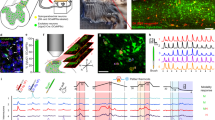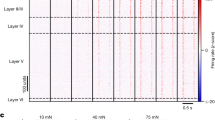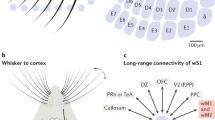Abstract
Stroking of the skin produces pleasant sensations that can occur during social interactions with conspecifics, such as grooming1. Despite numerous physiological studies (reviewed in ref. 2), molecularly defined sensory neurons that detect pleasant stroking of hairy skin3,4 in vivo have not been reported. Previously, we identified a rare population of unmyelinated sensory neurons in mice that express the G-protein-coupled receptor MRGPRB4 (refs 5, 6). These neurons exclusively innervate hairy skin with large terminal arborizations7 that resemble the receptive fields of C-tactile (CT) afferents in humans8. Unlike other molecularly defined mechanosensory C-fibre subtypes9,10, MRGPRB4+ neurons could not be detectably activated by sensory stimulation of the skin ex vivo. Therefore, we developed a preparation for calcium imaging in the spinal projections of these neurons during stimulation of the periphery in intact mice. Here we show that MRGPRB4+ neurons are activated by massage-like stroking of hairy skin, but not by noxious punctate mechanical stimulation. By contrast, a different population of C fibres expressing MRGPRD11 was activated by pinching but not by stroking, consistent with previous physiological and behavioural data10,12. Pharmacogenetic activation of Mrgprb4-expressing neurons in freely behaving mice promoted conditioned place preference13, indicating that such activation is positively reinforcing and/or anxiolytic. These data open the way to understanding the function of MRGPRB4 neurons during natural behaviours, and provide a general approach to the functional characterization of genetically identified subsets of somatosensory neurons in vivo.
This is a preview of subscription content, access via your institution
Access options
Subscribe to this journal
Receive 51 print issues and online access
$199.00 per year
only $3.90 per issue
Buy this article
- Purchase on Springer Link
- Instant access to full article PDF
Prices may be subject to local taxes which are calculated during checkout




Similar content being viewed by others
References
Morrison, I., Loken, L. S. & Olausson, H. The skin as a social organ. Exp. Brain Res. 204, 305–314 (2010)
Olausson, H., Wessberg, J., Morrison, I., McGlone, F. & Vallbo, A. The neurophysiology of unmyelinated tactile afferents. Neurosci. Biobehav. Rev. 34, 185–191 (2010)
Dunbar, R. I. The social role of touch in humans and primates: behavioural function and neurobiological mechanisms. Neurosci. Biobehav. Rev. 34, 260–268 (2010)
McGlone, F., Vallbo, A. B., Olausson, H., Loken, L. & Wessberg, J. Discriminative touch and emotional touch. Can. J. Exp. Psychol. 61, 173–183 (2007)
Dong, X., Han, S., Zylka, M. J., Simon, M. I. & Anderson, D. J. A diverse family of GPCRs expressed in specific subsets of nociceptive sensory neurons. Cell 106, 619–632 (2001)
Zylka, M. J., Dong, X., Southwell, A. L. & Anderson, D. J. Atypical expansion in mice of the sensory neuron-specific Mrg G protein-coupled receptor family. Proc. Natl Acad. Sci. USA 100, 10043–10048 (2003)
Liu, Q. et al. Molecular genetic visualization of a rare subset of unmyelinated sensory neurons that may detect gentle touch. Nature Neurosci. 10, 946–948 (2007)
Wessberg, J., Olausson, H., Fernström, K. W. & Vallbo, A. B. Receptive field properties of unmyelinated tactile afferents in the human skin. J. Neurophysiol. 89, 1567–1575 (2003)
Li, L. et al. The functional organization of cutaneous low-threshold mechanosensory neurons. Cell 147, 1615–1627 (2011)
Rau, K. K. et al. Mrgprd enhances excitability in specific populations of cutaneous murine polymodal nociceptors. J. Neurosci. 29, 8612–8619 (2009)
Zylka, M. J., Rice, F. L. & Anderson, D. J. Topographically distinct epidermal nociceptive circuits revealed by axonal tracers targeted to Mrgprd. Neuron 45, 17–25 (2005)
Cavanaugh, D. J. et al. Distinct subsets of unmyelinated primary sensory fibers mediate behavioral responses to noxious thermal and mechanical stimuli. Proc. Natl Acad. Sci. USA 106, 9075–9080 (2009)
Tzschentke, T. M. Measuring reward with the conditioned place preference (CPP) paradigm: update of the last decade. Addict. Biol. 12, 227–462 (2007)
Tian, L. et al. Imaging neural activity in worms, flies and mice with improved GCaMP calcium indicators. Nature Methods 6, 875–881 (2009)
Dussor, G., Zylka, M. J., Anderson, D. J. & McCleskey, E. W. Cutaneous sensory neurons expressing the Mrgprd receptor sense extracellular ATP and are putative nociceptors. J. Neurophysiol. 99, 1581–1589 (2008)
Edin, B. B., Essick, G. K., Trulsson, M. & Olsson, K. A. Receptor encoding of moving tactile stimuli in humans. I. Temporal pattern of discharge of individual low-threshold mechanoreceptors. J. Neurosci. 15, 830–847 (1995)
Panksepp, J. B. & Lahvis, G. P. Social reward among juvenile mice. Genes Brain Behav. 6, 661–671 (2007)
Panksepp, J. Cross-species affective neuroscience decoding of the primal affective experiences of humans and related animals. PLoS One 6, e21236 (2011)
Alexander, G. M. et al. Remote control of neuronal activity in transgenic mice expressing evolved G protein-coupled receptors. Neuron 63, 27–39 (2009)
Le Foll, B. & Goldberg, S. R. Nicotine induces conditioned place preferences over a large range of doses in rats. Psychopharmacology (Berl.) 178, 481–492 (2005)
Cunningham, C. L., Ferree, N. K. & Howard, M. A. Apparatus bias and place conditioning with ethanol in mice. Psychopharmacology (Berl.) 170, 409–422 (2003)
Johansen, J. P., Fields, H. L. & Manning, B. H. The affective component of pain in rodents: direct evidence for a contribution of the anterior cingulate cortex. Proc. Natl Acad. Sci. USA 98, 8077–8082 (2001)
LaBuda, C. J. & Fuchs, P. N. A behavioral test paradigm to measure the aversive quality of inflammatory and neuropathic pain in rats. Exp. Neurol. 163, 490–494 (2000)
Shields, S. D., Cavanaugh, D. J., Lee, H., Anderson, D. J. & Basbaum, A. I. Pain behavior in the formalin test persists after ablation of the great majority of C-fiber nociceptors. Pain 151, 422–429 (2010)
Löken, L. S., Wessberg, J., Morrison, I., McGlone, F. & Olausson, H. Coding of pleasant touch by unmyelinated afferents in humans. Nature Neurosci. 12, 547–548 (2009)
Woodbury, C. J., Ritter, A. M. & Koerber, H. R. Central anatomy of individual rapidly adapting low-threshold mechanoreceptors innervating the “hairy” skin of newborn mice: early maturation of hair follicle afferents. J. Comp. Neurol. 436, 304–323 (2001)
Olausson, H. et al. Unmyelinated tactile afferents signal touch and project to insular cortex. Nature Neurosci. 5, 900–904 (2002)
Foust, K. D., Poirier, A., Pacak, C. A., Mandel, R. J. & Flotte, T. R. Neonatal intraperitoneal or intravenous injections of recombinant adeno-associated virus type 8 transduce dorsal root ganglia and lower motor neurons. Hum. Gene Ther. 19, 61–70 (2008)
Davalos, D. et al. Stable in vivo imaging of densely populated glia, axons and blood vessels in the mouse spinal cord using two-photon microscopy. J. Neurosci. Methods 169, 1–7 (2008)
Johannssen, H. C. & Helmchen, F. In vivo Ca2+ imaging of dorsal horn neuronal populations in mouse spinal cord. J. Physiol. (Lond.) 588, 3397–3402 (2010)
Muzumdar, M. D., Tasic, B., Miyamichi, K., Li, L. & Luo, L. A global double-fluorescent Cre reporter mouse. Genesis 45, 593–605 (2007)
de Felipe, P. et al. E unum pluribus: multiple proteins from a self-processing polyprotein. Trends Biotechnol. 24, 68–75 (2006)
Meyers, E. N., Lewandoski, M. & Martin, G. R. An Fgf8 mutant allelic series generated by Cre- and Flp-mediated recombination. Nature Genet. 18, 136–141 (1998)
Raymond, C. S. & Soriano, P. ROSA26Flpo deleter mice promote efficient inversion of conditional gene traps in vivo. Genesis 48, 603–606 (2010)
Bunting, M., Bernstein, K. E., Greer, J. M., Capecchi, M. R. & Thomas, K. R. Targeting genes for self-excision in the germ line. Genes Dev. 13, 1524–1528 (1999)
Zolotukhin, S. et al. Recombinant adeno-associated virus purification using novel methods improves infectious titer and yield. Gene Ther. 6, 973–985 (1999)
Hamada, F. N. et al. An internal thermal sensor controlling temperature preference in Drosophila. Nature 454, 217–220 (2008)
Hamilton, S. G., McMahon, S. B. & Lewin, G. R. Selective activation of nociceptors by P2X receptor agonists in normal and inflamed rat skin. J. Physiol. (Lond.) 534, 437–445 (2001)
Berry, J. A., Cervantes-Sandoval, I., Nicholas, E. P. & Davis, R. L. Dopamine is required for learning and forgetting in Drosophila. Neuron 74, 530–542 (2012)
Acknowledgements
We thank R. Robertson for programming and imaging data analysis; M. Walsh and T. Heitzman for the stimulus delivery system and associated electronics; M. Zelikowsky for help with statistical analysis of behavioural data; H. Inagaki for experimental advice and comments on the manuscript; S. Pease for help with generation of knock-in mice; N. Verduzco, K. Lee and R. Sauza for mice colony maintenance; M. Visel and J. Flannery for training in AAV8 preparation; A. Anderson and C. Pagan for initial experiments using their stereotaxic apparatus; J. Zhang and A. Basbaum for teaching the dorsal laminectomy and for comments on the manuscript; D. Davalos, K. Akassoglou and H. Johanssen for help with the in vivo imaging preparation; L. Lagnado and B. Odermatt for SypHy and SyGCamp2 plasmids; C. Shea and M. Martinez for technical assistance; H. Oates-Barker for laboratory management and G. Mancuso for administrative assistance. This work was supported by NIH grants 5PO1NS-48499 and 5R01 NS023476, and by fellowships from EMBO and the Human Frontiers Science Program (S.V.) and the Helen Hay Whitney Foundation (A.M.W.). D.J.A. is an Investigator of the Howard Hughes Medical Institute.
Author information
Authors and Affiliations
Contributions
S.V. carried out all imaging and behavioural experiments; A.M.W. helped to configure the two-photon imaging system and developed the light grid method; K.K.R. and H.R.K. carried out electrophysiological recordings in isolated skin-nerve preparations; D.J.A. participated in experimental design and data interpretation and wrote the manuscript together with S.V.
Corresponding author
Ethics declarations
Competing interests
The authors declare no competing financial interests.
Supplementary information
Supplementary Information
This file contains Supplementary Figures 1-14, Supplementary Tables 1-3, a Supplementary Discussion, Supplementary Notes 1-10 and additional references. (PDF 4144 kb)
Rights and permissions
About this article
Cite this article
Vrontou, S., Wong, A., Rau, K. et al. Genetic identification of C fibres that detect massage-like stroking of hairy skin in vivo . Nature 493, 669–673 (2013). https://doi.org/10.1038/nature11810
Received:
Accepted:
Published:
Issue Date:
DOI: https://doi.org/10.1038/nature11810
This article is cited by
-
Loss of G9a does not phenocopy the requirement for Prdm12 in the development of the nociceptive neuron lineage
Neural Development (2024)
-
Perspective of Calcium Imaging Technology Applied to Acupuncture Research
Chinese Journal of Integrative Medicine (2024)
-
The NOP Receptor System in Neurological and Psychiatric Disorders: Discrepancies, Peculiarities and Clinical Progress in Developing Targeted Therapies
CNS Drugs (2021)
-
Neurochemical and Ultrastructural Characterization of Unmyelinated Non-peptidergic C-Nociceptors and C-Low Threshold Mechanoreceptors Projecting to Lamina II of the Mouse Spinal Cord
Cellular and Molecular Neurobiology (2021)
-
Parallel ascending spinal pathways for affective touch and pain
Nature (2020)
Comments
By submitting a comment you agree to abide by our Terms and Community Guidelines. If you find something abusive or that does not comply with our terms or guidelines please flag it as inappropriate.



